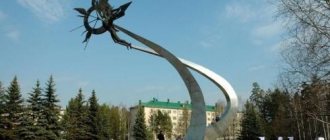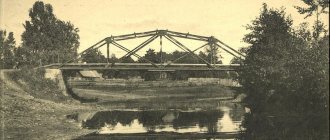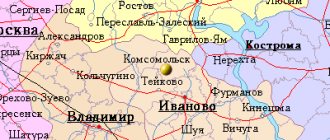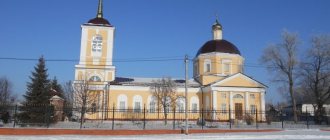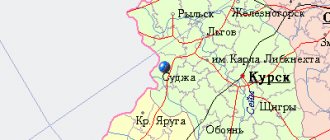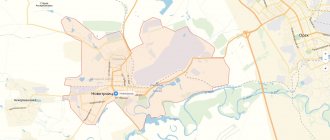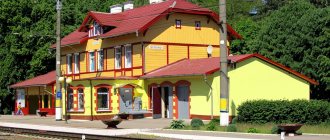Lyuban
, a city in Russia, part of the Tosnensky district of the Leningrad region, the administrative center of the Lyubansky urban settlement, within the Tosnensky deanery of the Gatchina diocese. Located at the southern foot of the Baltic-Ladoga ledge, on the Tigoda River, a tributary of the Volkhov River, 85 km southeast of St. Petersburg. Railway station on the St. Petersburg-Moscow line. Population - 4.6 thousand people. (2018)
- On the map: Yandex.Map, Google map
It was first mentioned in Novgorod scribe books in 1500 as the trading settlement of Lyuban. The name is derived from the common toponymic basis of any
using the suffix
-an
.
On January 2, 1711, a postal route was established between St. Petersburg and Moscow, passing through Lyuban. One of the chapters of Alexander Nikolaevich Radishchev’s book “Journey from St. Petersburg to Moscow” is dedicated to Lyuban.
In the spring of 1843, construction of a railway line began between St. Petersburg and Moscow, in 1849 the first passenger train passed through Lyuban, and in 1850 a railway station building was built.
In 1867, next to the station, the Peter and Paul Church was built according to the design of the architect K. A. Ton, which is the only temple of railway workers in Russia. In 1868 the first railway school was built.
From the middle of the 19th century, Lyuban became the volost center of the Novgorod district of the Novgorod province, and one of the popular summer cottages for residents of St. Petersburg.
In 1912, Lyuban received city status.
From 1917 to 1927 - the administrative center of the Lyuban volost of the Novgorod district of the Novgorod province.
From 1927 to 1930 - the administrative center of the Lyubansky district of the Leningrad region.
In 1930 it became part of the Tosnensky district of the Leningrad region.
On August 25, 1941, during the Great Patriotic War, it was occupied by Nazi troops. Liberated on January 28, 1944 by troops of the Volkhov Front during the Novgorod-Luga operation.
Since February 1, 1963, the city has been subordinate to the Tosno City Council.
On January 1, 2006, the municipal entity “Lyuban urban settlement” was formed, and Lyuban became its administrative center.
Guides: Poland
Wroclaw
Krakow city
May be interesting: Other cities in Poland
Notes
- ↑ 123
The permanent population of the Russian Federation by municipalities as of January 1, 2022 (Russian). Retrieved April 27, 2022. Archived May 2, 2022. - Encyclopedia “Culture of the Leningrad Region. Lyuban"
- Encyclopedia “Culture of the Leningrad Region”
- Census quitrent book of the Vodskaya Pyatina of 1500. P. 372
- (unspecified)
(inaccessible link). Date accessed: November 11, 2012. April 27, 2020. - Hydrological station Lyuban is 125 years old | Official portal of the St. Petersburg CGMS-R, weather forecast for St. Petersburg for three days
- Matveev S.P.
Materials on statistics of the Novgorod province. Lists of populated places and information about settlements of the Novgorod province. Novgorod district. Novgorod. 1884. pp. 10, 12 - Volosts and the most important villages of European Russia. Issue VII. Provinces of the lakeside group. St. Petersburg 1885. P. 21
- Populated areas of the Russian Empire according to the first general census of 1897 St. Petersburg. 1905. P. 126
- List of populated places in the Novgorod province. Issue I. Novgorod district, ed. V. A. Podobedova. 1907. pp. 32, 33
- Collection of resolutions concerning the administrative-territorial division of Russia for 1917-1922. - M.: Publishing House of the All-Russian Central Executive Committee, 1922. - P. 11, paragraph 19
- Volost councils of the Leningrad province (undefined)
. Archived from the original on July 7, 2015. - Rykshin P. E.
Administrative-territorial structure of the Leningrad region. - L.: Publishing house of Lenoblast Executive Committee and Lensovet, 1933. - 444 p. — P. 81, 419 - Administrative and economic reference book for the regions of the Leningrad region / Adm.-territorial. commission Lenoblast Executive Committee; comp. Bogomolov F. I.
,
Komlev P. E
.;
under general ed. Nuzhnogo A.F.
- M.: Publishing house of Lenoblast Executive Committee and Lensovet, 1936. - 383 p. — P. 200 - Returned names (undefined)
(inaccessible link -
history
). - Alexy (Simansky), Metropolitan of Leningrad
. Alphabetical list of the clergy of the Leningrad region on May 1, 1937. Publication by A. A. Bovkalo and A. K. Galkin. St. Petersburg: Prince Vladimir Cathedral, 2014. pp. 54, 63 - Shkarovsky M.V.
The Church calls for the defense of the Motherland. Religious life of Leningrad and the North-West during the Great Patriotic War, 1941-1945. St. Petersburg: Satis, 2005. pp. 297-298 - Leningrad Regional State Archives. R-751
- Directory of the history of the administrative-territorial division of the Leningrad region
- Administrative-territorial division of the Leningrad region / Comp. T. A. Badina. — Directory. - L.: Lenizdat, 1966. - P. 117. - 197 p. — 8000 copies.
- ↑ 1 2 3 4 5 6 7 8 9 10 People
's encyclopedia “My City”.
Lyuban (Leningrad region) (undefined)
. Retrieved July 5, 2014. Archived July 5, 2014. - All-Union Population Census of 1939. The size of the urban population of the USSR by urban settlements and intra-city areas (unspecified)
. Retrieved November 30, 2013. Archived November 30, 2013. - All-Union Population Census of 1959. The size of the urban population of the RSFSR, its territorial units, urban settlements and urban areas by gender (Russian). Demoscope Weekly. Access date: September 25, 2013. Archived April 28, 2013.
- All-Union Population Census of 1970 The size of the urban population of the RSFSR, its territorial units, urban settlements and urban areas by gender. (Russian). Demoscope Weekly. Access date: September 25, 2013. Archived April 28, 2013.
- All-Union Population Census of 1979 The size of the urban population of the RSFSR, its territorial units, urban settlements and urban areas by gender. (Russian). Demoscope Weekly. Access date: September 25, 2013. Archived April 28, 2013.
- All-Union population census of 1989. Urban population (undefined)
. Archived from the original on August 22, 2011. - All-Russian population census 2002. Volume. 1, table 4. Population of Russia, federal districts, constituent entities of the Russian Federation, districts, urban settlements, rural settlements - regional centers and rural settlements with a population of 3 thousand or more (unspecified)
. Archived from the original on February 3, 2012. - Administrative-territorial division of the Leningrad region: [reference] / under general. ed. V. A. Skorobogatova, V. V. Pavlova; comp. V. G. Kozhevnikov. - St. Petersburg, 2007. - 281 p. (undefined)
. Retrieved April 26, 2015. Archived April 26, 2015. - Cities of the Leningrad Region (number of inhabitants - estimate as of January 1, 2008, thousand people) (unspecified)
. Retrieved July 6, 2016. Archived July 6, 2016. - The size of the permanent population of the Russian Federation by cities, urban-type settlements and regions as of January 1, 2009 (unspecified)
. Retrieved January 2, 2014. Archived January 2, 2014. - All-Russian population census 2010. Leningrad region (undefined)
. Access date: August 10, 2014. Archived August 10, 2014. - Population of the Russian Federation by municipalities. Table 35. Estimated resident population as of January 1, 2012 (unspecified)
. Retrieved May 31, 2014. Archived May 31, 2014. - Population of the Russian Federation by municipalities as of January 1, 2013. - M.: Federal State Statistics Service Rosstat, 2013. - 528 p. (Table 33. Population of urban districts, municipal districts, urban and rural settlements, urban settlements, rural settlements) (undefined)
. Retrieved November 16, 2013. Archived November 16, 2013. - Table 33. Population of the Russian Federation by municipalities as of January 1, 2014 (unspecified)
. Access date: August 2, 2014. Archived August 2, 2014. - Population of the Russian Federation by municipalities as of January 1, 2015 (unspecified)
. Access date: August 6, 2015. Archived August 6, 2015. - Population of the Russian Federation by municipalities as of January 1, 2016 (Russian) (October 5, 2018). Retrieved May 15, 2022. Archived May 8, 2022.
- Population of the Russian Federation by municipalities as of January 1, 2022 (Russian) (July 31, 2017). Retrieved July 31, 2022. Archived July 31, 2022.
- Population of the Russian Federation by municipalities as of January 1, 2022 (Russian). Retrieved July 25, 2018. Archived July 26, 2022.
- Population of the Russian Federation by municipalities as of January 1, 2022 (Russian). Retrieved July 31, 2019. Archived May 2, 2022.
- Population of the Russian Federation by municipalities as of January 1, 2022 (Russian). Date accessed: October 17, 2022. Archived October 17, 2022.
- taking into account the cities of Crimea
- https://rosstat.gov.ru/storage/mediabank/bul_Chislen_nasel_MO-01-01-2021.rar Population of the Russian Federation by municipalities as of January 1, 2022 (1.85 Mb, 07/30/2021)
- Rykshin P. E.
Administrative-territorial structure of the Leningrad region. - L.: Publishing house of Lenoblast Executive Committee and Lensovet, 1933. - 444 p. — P. 93 - Administrative and economic reference book for the regions of the Leningrad region / Adm.-territorial. commission Lenoblast Executive Committee; comp. Bogomolov F. I.
,
Komlev P. E
.;
under general ed. Nuzhnogo A.F.
- M.: Publishing house of Lenoblast Executive Committee and Lensovet, 1936. - 383 p. — P. 20 - Final results of the population census as of October 14, 2010
- Directory of transport schedules for the Russian Federation and neighboring countries
Story
Lyuban grew from a small West Slavic settlement, probably founded in the 9th century. In the 10th century, these lands were conquered by Saxony. From 1002 to 1031, Luban was part of Poland, then of the Holy Roman Empire. In the 12th century, Frederick Barbarossa transferred the settlement to the Czech kings, under whose rule Luban turned into a major trading center and even received city rights in 1220.
In the Middle Ages, the center of the city was a square market with perpendicular streets leading to four gates. The first brewery was founded here in the 13th century. By the way, local beer was famous throughout Silesia. In the 14th century, Luban became part of the union of six Lusatian cities (Bautzen, Görlitz, Kamenets, Lubau and Zittau). However, twice, in 1427 and 1431, the Hussites completely destroyed the city. Although after that it was quickly restored.
Lyuban. Old city
In 1469 the city became part of Hungary, but already in 1490 it again became part of Bohemia (Czech Republic). Luban fell into decline after the Thirty Years' War and was transferred to Saxony in 1635. After the Napoleonic Wars in 1815, the Lusatian territories were annexed by the Kingdom of Prussia and after the Congress of Vienna were included in Silesia. In fact, Luban was part of Germany until the end of World War II.
Transport
The St. Petersburg - Moscow railway line runs through the city. All suburban electric trains passing through it stop at Lyuban station, as well as Lastochka electric trains heading to Bologoe, Veliky Novgorod, Staraya Russa, Valdai.
The following roads pass through the city:
- M10 (E 105) “Russia” (St. Petersburg - Moscow)
- 41A-004 (Pavlovo - Mga - Luga).
There are 9 suburban bus routes departing from Lyuban station[46]. Route No. 320 connects Lyuban with Tosno.
Attractions
Town Hall
The Town Hall is a historical building from the 16th century in the style of Renaissance architecture with a beautiful Baroque tower. It is a three-story rectangular building with a hip roof. On the main facade of the town hall there are two portals, which belong to the most interesting works of the Silesian Renaissance.
Nearby is the ancient Kramar Tower - a relic of the first town hall, built in the first half of the 13th century. The tower itself was most likely built in the 14th century. The town hall was damaged by a fire in 1487 and fell into disrepair. The building was then demolished. The demolition did not affect the tower around which the residential buildings were built.
City walls of Lyuban
Luban was surrounded by walls in the 14th century. They were built from basalt stone, which was quarried from nearby quarries. Initially, the city fortifications were surrounded by a moat. The double ring of walls contained the four main city gates. To this day, sections of the medieval city walls have been preserved on Podwale Street.
Bratskaya Tower
The Bratskaya Tower is a stone medieval tower from the 14th century and one of the main attractions of Lyuban. The tower was once part of the Brac City Gate, which was dismantled in the 19th century.
Salt House
The Salt House is an old barn from the 16th century, part of the city’s defensive wall complex. The building, originally conceived as a warehouse for salt and grain, was built in 1537-1539 on the initiative of the city council.
After being partially destroyed by fire in 1554, the building was extended at the end of the 17th century and then partially reconstructed in the 19th century, when it was adapted for use as a prison and fire station. Today the building is not used in any way.
Trinitarian Tower
The Trinitarian Tower is the belfry of the medieval Church of the Holy Trinity, the only thing that has survived from this ancient structure. The exact date of construction of the Church of the Holy Trinity is unknown, but it is assumed that it happened in the first half of the 13th century, most likely after Luban received city rights. In 1760, the church was destroyed by a strong fire and later demolished.
Church of the Holy Trinity
The Church of the Holy Trinity is an impressive neo-Gothic brick church built in the second half of the 19th century.
Church of the Virgin Mary
The Church of the Virgin Mary is a small ancient church founded in the 14th century and destroyed by the Hussites in 1427. The current building was built in 1452.
Demography
| Population | ||||||||
| 1897[21] | 1926[21] | 1931[21] | 1932 | 1933 | 1935 | 1939[22] | 1959[23] | 1970[24] |
| 2285 | ↗4300 | ↗4400 | ↗6500 | ↗7100 | ↘7000 | ↗8681 | ↘7139 | ↘6970 |
| 1979[25] | 1989[26] | 1992[21] | 1996[21] | 1998[21] | 2000 | 2002[27] | 2003[21] | 2005[21] |
| ↗7057 | ↘5078 | ↘4700 | ↘4300 | ↘4200 | ↘4100 | ↗4616 | ↘4600 | ↘4500 |
| 2006[28] | 2007[21] | 2008[29] | 2009[30] | 2010[31] | 2011[21] | 2012[32] | 2013[33] | 2014[34] |
| →4500 | →4500 | →4500 | ↗4518 | ↘4188 | ↗4200 | ↗4377 | ↗4474 | ↗4594 |
| 2015[35] | 2016[36] | 2017[37] | 2018[38] | 2019[39] | 2020[40] | 2021[1] | ||
| ↗4615 | ↘4610 | →4610 | ↘4566 | ↘4527 | ↘4444 | ↘4324 | ||
As of January 1, 2022, in terms of population, the city was in 1079th place out of 1116[41]cities of the Russian Federation[42].
Lyuban is one of the smallest cities in Russia in terms of population[43][44][45][1].
Guides: Poland
Szczecin
Poland
May be interesting: Other cities in Poland
